Accelerate IT operations with AI-driven Automation
Automation in IT operations enable agility, resilience, and operational excellence, paving the way for organizations to adapt swiftly to changing environments, deliver superior services, and achieve sustainable success in today's dynamic digital landscape.
Driving Innovation with Next-gen Application Management
Next-generation application management fueled by AIOps is revolutionizing how organizations monitor performance, modernize applications, and manage the entire application lifecycle.
AI-powered Analytics: Transforming Data into Actionable Insights
AIOps and analytics foster a culture of continuous improvement by providing organizations with actionable intelligence to optimize workflows, enhance service quality, and align IT operations with business goals.
Software development has long been synonymous with software engineering—a discipline rooted in structured methodologies, optimization, and efficiency. However, the emergence of artificial intelligence (AI) and agent-driven automation is catalyzing a seismic shift, redefining software development from a structured engineering process to a more dynamic act of software creation.
According to Gartner, by 2027, 80% of software engineering tasks will be automated, drastically reducing the need for manual coding. This shift mirrors the transformation witnessed in the music industry: composers no longer create every sound from scratch; they assemble and arrange pre-existing instruments and digital assets to craft unique compositions. Similarly, future software development will focus on curating and orchestrating pre-built software components rather than building everything from the ground up.
As AI moves beyond being a mere assistant to an active collaborator, software development is evolving from coding-centric workflows to an experience-first paradigm. The future isn’t about writing code—it’s about designing adaptive, intelligent, and user-centric experiences.

AI is no longer an assistant; it’s a collaborator. The future of software development isn’t about writing code—it’s about designing experiences.
Guru Kandarpi, Head of Global Service Lines, Quinnox
From Development to Composition: The Evolution of Software Engineering
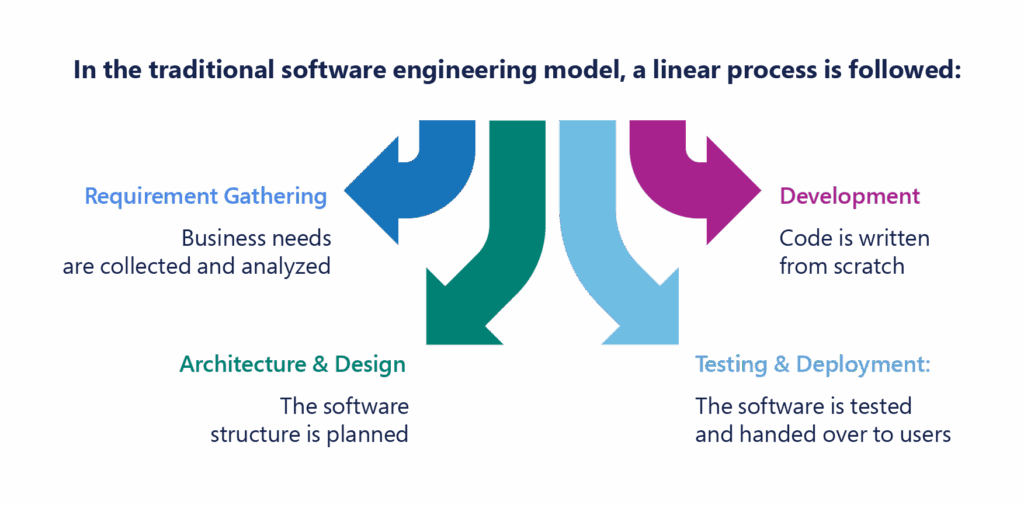
This approach required specialized roles such as architects, designers, developers, and testers, all working together to build software solutions. Efficiency was paramount, leading to the creation of accelerators, reusable assets, and frameworks that expedited development.
In contrast, the future of software creation is driven by pre-built components and AI-assisted automation. The shift is characterized by:
- APIs & Pre-built Modules: Instead of writing new code for common functionalities, businesses will leverage existing APIs and packages.
- AI-Generated Code: AI agents, such as Copilots, will generate custom logic dynamically, eliminating manual coding efforts.
- Software as Composition: Developers will transition into “composers” who arrange pre-built software elements to craft solutions tailored to business needs.
The Role of the Software Composer: From Coders to Creators
In this new paradigm, software creators will function like music composers. While the instruments (APIs, databases, automation tools) remain the same, the composition—how these elements are orchestrated—will define the end-user experience.
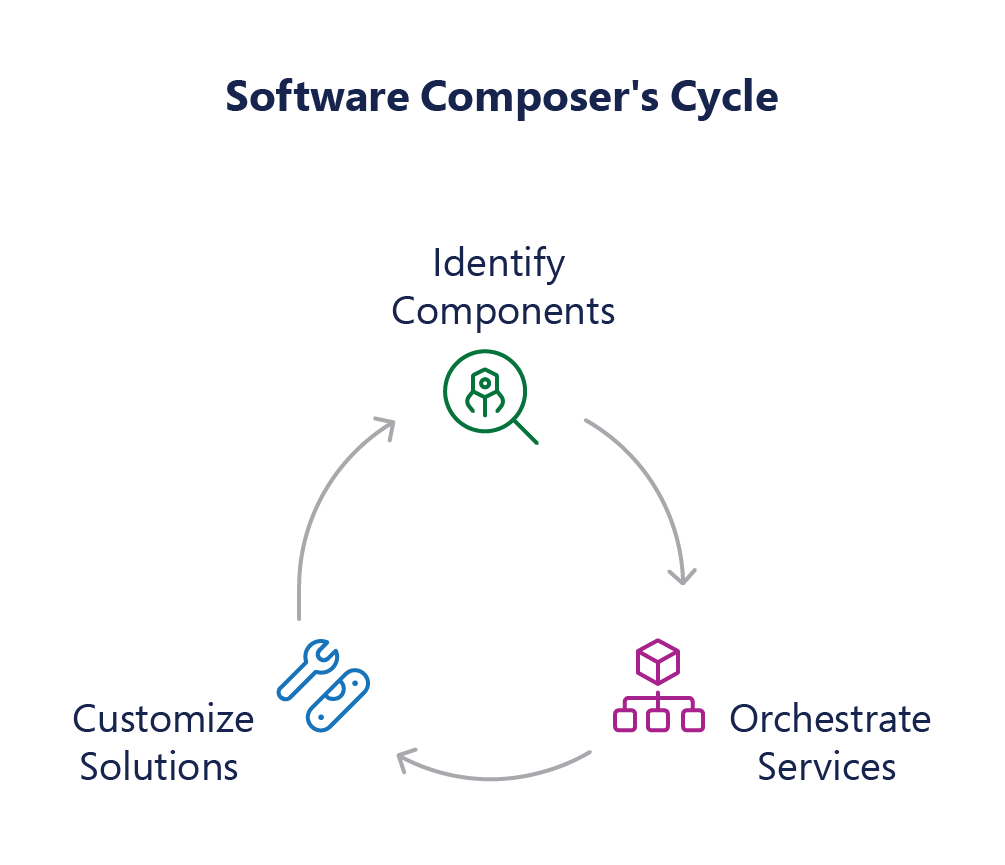
For example, take an e-commerce business launching a new mobile app. In the past, the company would need:
- A dedicated payment gateway integration team.
- Backend engineers writing custom inventory management code.
- A separate team handling recommendation engine logic.
Today, the same business can leverage:
- APIs for secure payments.
- AI-driven inventory manager to prevent stockouts.
- AI-powered recommendation engines to personalize shopping experiences.
This plug-and-play model reduces launch timelines from 6 months to just 6 weeks while ensuring a scalable and resilient system.
A recent survey found that 48% of M&A professionals are now using AI in their due diligence processes, a substantial increase from just 20% in 2018, highlighting the growing recognition of AI’s potential to transform M&A practices.
The Future Workforce: From Efficiency to Experience-Driven Development
The transition to software creation necessitates a rethinking of talent acquisition and training. Traditionally, companies focused on hiring developers skilled in programming languages and frameworks. However, in the new world of AI-driven development, efficiency will no longer be the primary goal—experience will.
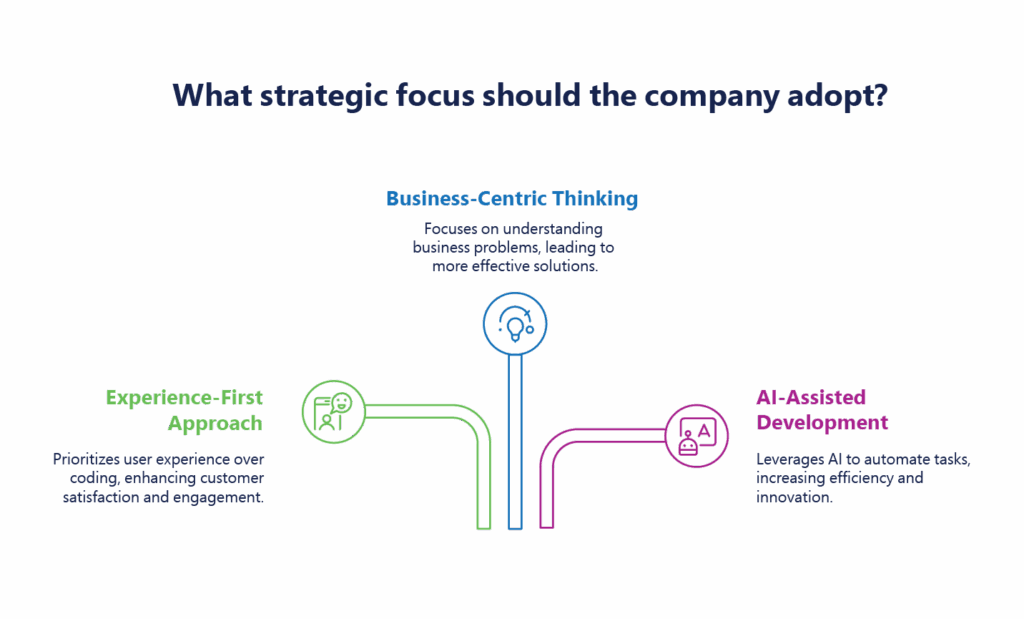
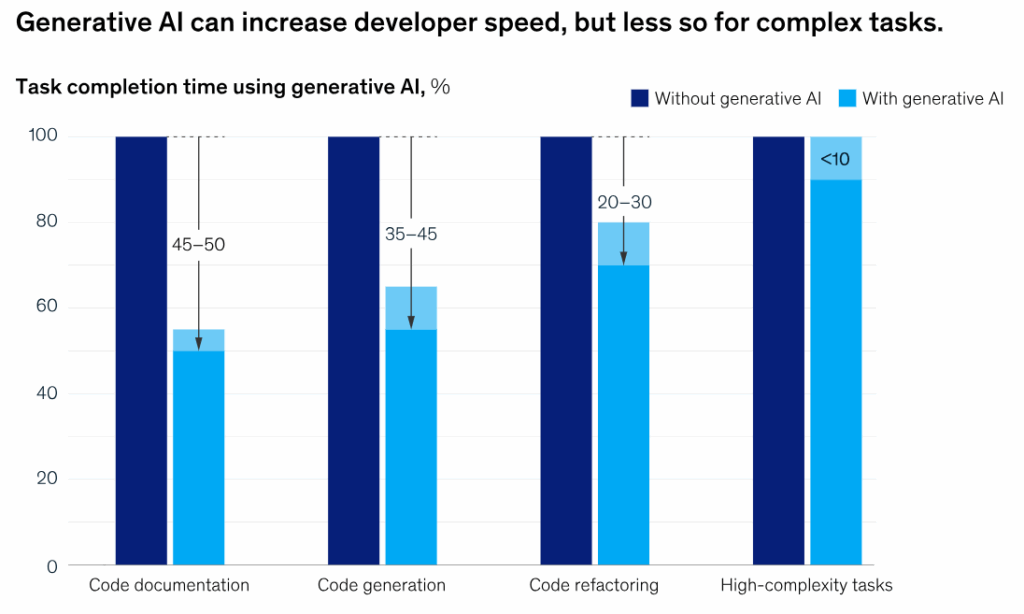
Source: McKinsey & Company

The Co-Create Model: A Framework for AI-Driven Software Development
To embrace this transformation, organizations must adopt a new framework—the Co-Create model, which focuses on four pillars:
Talent (T) – Building AI-Native Teams
- Hiring software composers rather than traditional programmers.
- Investing in AI and automation training for existing employees.
Organizational Structure (O) – Moving Beyond Silos
- Restructuring teams around value streams rather than rigid departments.
- Encouraging cross-functional collaboration between developers, AI specialists, and business strategists.
Process (P) – AI-First Development Methodology
- Shifting from manual coding to AI-assisted rapid prototyping.
- Using AI-driven test automation to enhance software reliability.
Platforms (P) – Creating Digital Studios for Rapid Innovation
- Establishing centralized AI-powered development hubs.
- Providing real-time visibility into pre-built components and automation tools.
This T.O.P.P. model ensures that businesses remain agile and future-ready in an AI-powered world.
Looking Ahead: The Next Decade of Software Development
The shift from software engineering to software creation is inevitable. Over time, organizations will see:
- Increased Speed: AI-driven automation will reduce development cycles from weeks to minutes.
- Greater Adaptability: Pre-built components will allow businesses to pivot quickly.
- Enhanced User Experience: Focus on seamless integration and customer-centric designs.
- Composable Enterprise Architectures: Companies will shift to modular, reusable software.
While the transition will not happen overnight, companies must start preparing for this future by investing in AI-driven platforms, talent reskilling, and restructured development processes.
The Bottom Line: From Engineering to Experience-Led Software Creation
The age of software engineering is giving way to the era of software creation. Businesses that embrace this change will thrive, while those clinging to traditional development methods may struggle to keep up. As we embark on this journey, the role of software creators will be to orchestrate available resources, much like a composer arranges instruments to craft a masterpiece.
The Co-Create model is designed to navigate this transformation, equipping organizations with the tools, processes, and talent needed to lead in an AI-powered world. The time to start preparing for this shift is now.
At Quinnox, we help businesses accelerate software creation with AI-driven development, intelligent automation, and a composable approach. Our next-gen application development solutions empower enterprises to innovate faster, reduce technical debt, and enhance user experiences—ensuring they stay ahead in this dynamic digital era.
Are you ready to co-create the future of software? Let’s build it together. Connect with our experts today!
1. Streamline Development and Deployment:
- Facilitate the initial design and configuration of agents, including goal definition, algorithm selection, and data source configuration.
- Enable seamless deployment across diverse environments, such as cloud platforms, on- premise servers, and edge devices.
4. Telecommunications
Dynamic Risk Assessment: In telecom, data privacy regulations (like GDPR) are crucial. AI assesses the impact of privacy regulations on customer data handling practices, ensuring compliance without compromising service.
Example: AI helps telecom providers audit data storage practices to align with GDPR, ensuring customer privacy and regulatory adherence.
5. Retail
Automated Policy and Document Updates: Retailers must adapt to consumer protection and employee rights regulations. AI updates internal policies based on regulatory changes, keeping customer interactions and employee practices compliant.
Example: AI generates new training material for customer service teams when consumer rights regulations are updated, ensuring compliance with minimal manual effort.
With iAM, every application becomes a node within a larger, interconnected system. The “intelligent” part isn’t merely about using AI to automate processes but about leveraging data insights to understand, predict, and improve the entire ecosystem’s functionality.
Consider the practical applications:
Consider a large financial institution seeking to improve its customer service experience. By leveraging Agent Management Services, the institution can:
- Deploy a network of Al-powered agents capable of handling a wide range of customer inquiries, such as account balance inquiries, transaction history checks, and basic support requests.
- Train and optimize these agents to accurately understand customer intent, provide timely and helpful responses, and even anticipate customer needs proactively.
- Ensure the security and compliance of these agents, safeguarding sensitive customer data and adhering to strict financial regulations.
- Continuously monitor and refine agent performance, identifying areas for improvement and making necessary adjustments to optimize the customer experience.
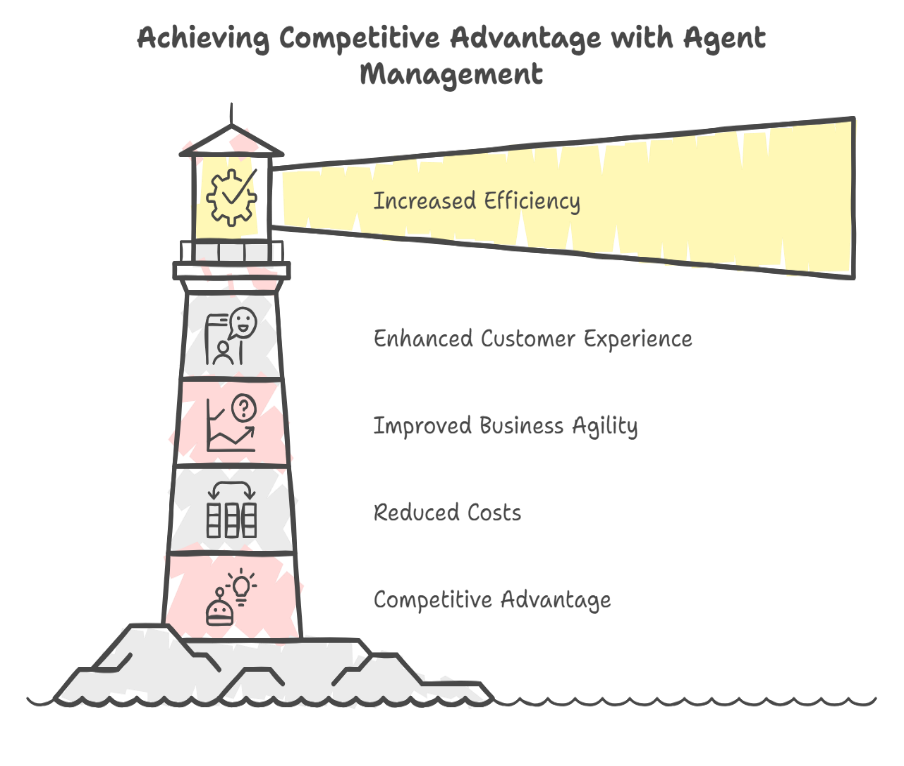
- Increased Efficiency and Productivity: Automating routine tasks and streamlining workflows, freeing up human resources for more strategic initiatives.
- Enhanced Customer Experience: Delivering personalized and efficient customer service, improving customer satisfaction and loyalty.
- Improved Business Agility: Enabling faster response times to changing market conditions and customer demands.
- Reduced Costs: Optimizing resource allocation and minimizing operational expenses.
- Competitive Advantage: Gaining a competitive edge by leveraging the power of Al and automation to innovate and deliver superior products and services.
Conclusion:
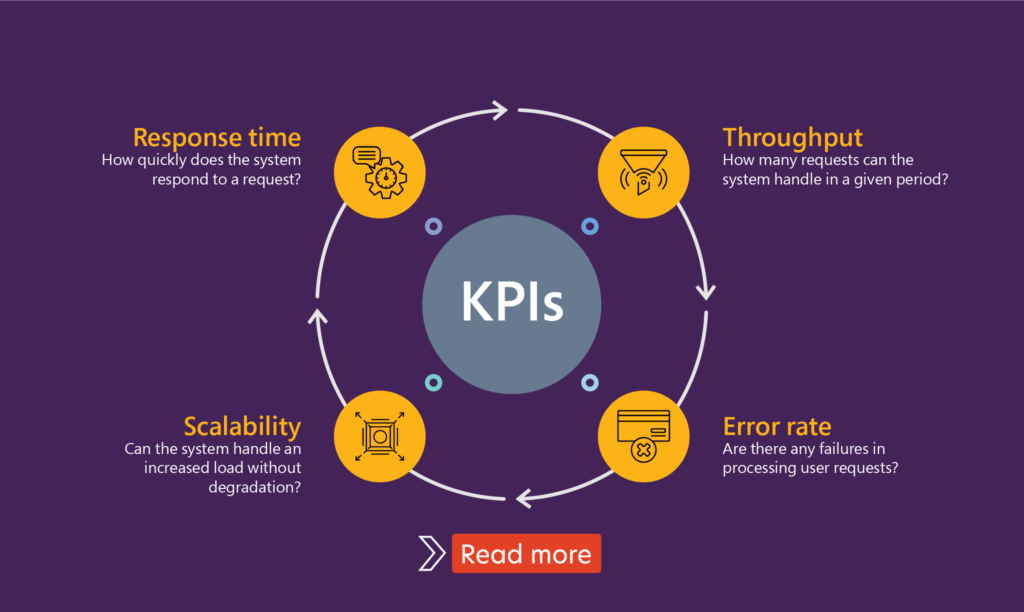
Qinfinite’s Auto Discovery continuously scans and maps your entire enterprise IT landscape, building a real-time topology of systems, applications, and their dependencies across business and IT domains. This rich understanding of the environment is captured in a Knowledge Graph, which serves as the foundation for making sense of observability data by providing vital context about upstream and downstream impacts.
2. Deep Data Analysis for Actionable Insights:
Qinfinite’s Deep Data Analysis goes beyond simply aggregating observability data. Using sophisticated AI/ML algorithms, it analyzes metrics, logs, traces, and events to detect patterns, anomalies, and correlations. By correlating this telemetry data with the Knowledge Graph, Qinfinite provides actionable insights into how incidents affect not only individual systems but also business outcomes. For example, it can pinpoint how an issue in one microservice may ripple through to other systems or impact critical business services.
3. Intelligent Incident Management: Turning Insights into Actions:
Qinfinite’s Intelligent Incident Management takes observability a step further by converting these actionable insights into automated actions. Once Deep Data Analysis surfaces insights and potential root causes, the platform offers AI-driven recommendations for remediation. But it doesn’t stop there, Qinfinite can automate the entire remediation process. From restarting services to adjusting resource allocations or reconfiguring infrastructure, the platform acts on insights autonomously, reducing the need for manual intervention and significantly speeding up recovery times.
By automating routine incident responses, Qinfinite not only shortens Mean Time to Resolution (MTTR) but also frees up IT teams to focus on strategic tasks, moving from reactive firefighting to proactive system optimization.
Did you know? According to a report by Forrester, companies using cloud-based testing environments have reduced their testing costs by up to 45% while improving test coverage by 30%.
Frequently Asked Questions (FAQs)
Software engineering follows a structured approach to software development, focusing on coding, optimization, and efficiency. Software creation, on the other hand, leverages AI, automation, and pre-built components to design software experiences rather than manually coding everything from scratch.
AI is automating repetitive tasks, generating code, enhancing software testing, and enabling real-time decision-making. AI-powered tools like Copilots, AI agents, and low-code platforms are reducing manual coding efforts and allowing developers to focus on business logic and user experience.
The Co-Create model is a framework built on four pillars—Talent, Organization, Process, and Platform (T.O.P.P.)—that enables businesses to transition from conventional software development to AI-assisted creation. It emphasizes cross-functional collaboration, AI-native talent, adaptive processes, and digital platforms that accelerate innovation.
AI-driven software development accelerates time-to-market, enhances user experiences, improves decision-making with data-driven insights, reduces manual effort through automation, and ensures scalability and adaptability across industries like banking, healthcare, retail, and manufacturing.
Start by assessing your current development processes, identifying areas where AI can enhance efficiency, and partnering with experts who specialize in AI-driven software development.
